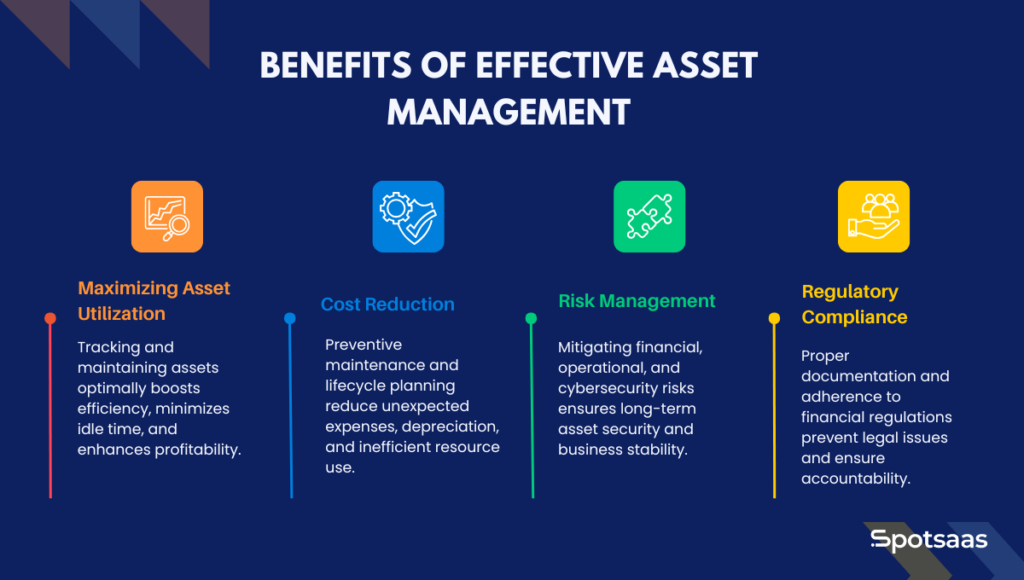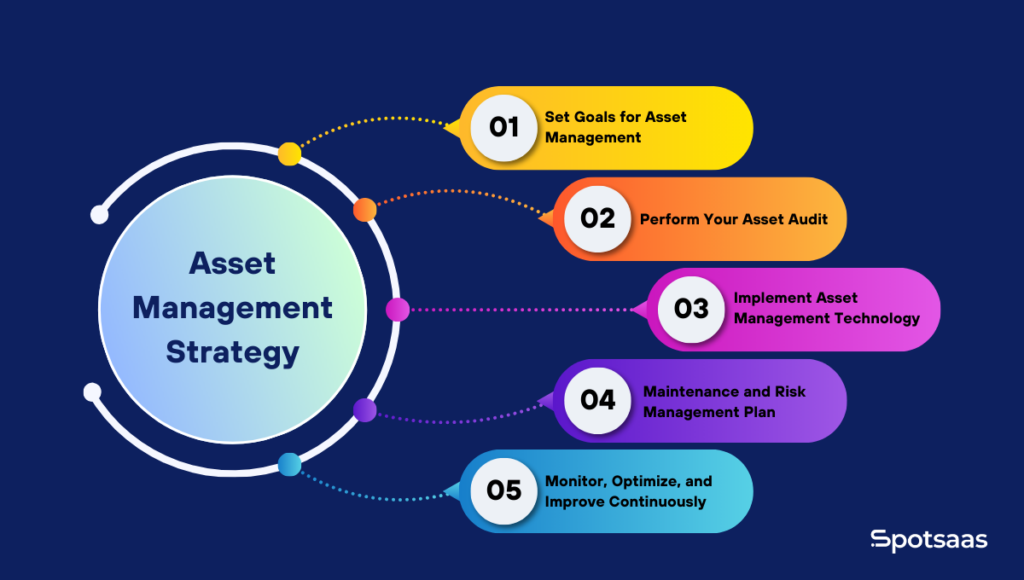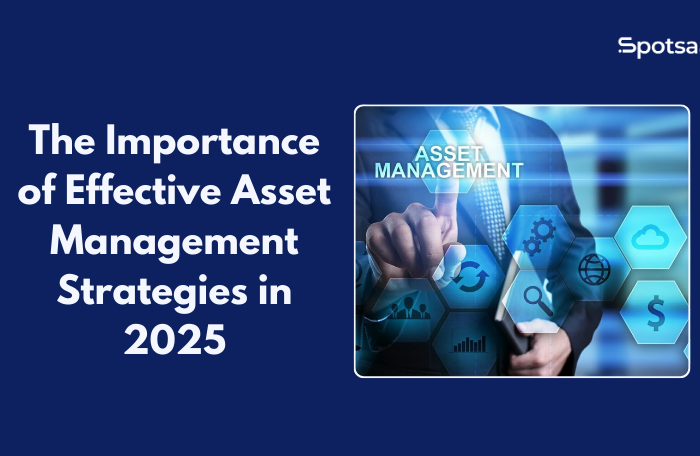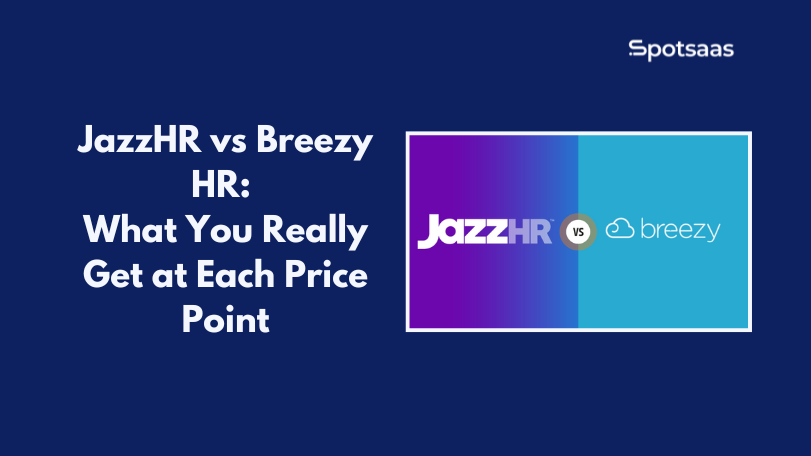Asset management can make or mar a business operation and personal finance by putting resources to task, reducing risks, and creating long-term income whether physical assets such as machinery and real estate or monetary assets like stocks and investments, a somewhat rigid approach to asset management serves to optimize their usage and preserve value.
Best asset management approaches would be a combination of tracking, reducing risks, financial planning, and integrating technology. This guide will help businesses and individuals through informed choices towards long-term financial health and sustainable growth.
What is Asset Management?
Asset management entails gaining, operating, and optimizing the asset in question, thereby maximizing its value over time in a systematic manner. This applies to both corporate and others, in helping to ensure proper utilization of resources, minimized risk, and the fulfillment of financial goals.
In the case of an enterprise asset management primarily serves to measure and manage the physical assets of the company, including machines, property, and inventory, in order to enhance their efficiency, reduce operational costs and extend the economic life of each asset. For the private citizen, the focus is mainly on financial assets ranging from investments to retirement funds to land for the creation of wealth and economic security.
Types of Asset Management
Physical Asset Management
Businesses rely on physical asset management to monitor, maintain, and optimize tangible resources, ensuring that equipment, infrastructure, and inventory remain in optimal condition.
- Examples: Equipment, buildings, vehicles, technology, and office supplies.
- Key Objective: Minimize depreciation, prevent downtime, and maximize asset performance.
- Common Tools Used: Asset tracking software, preventive maintenance programs, and lifecycle management strategies.
Financial Asset Management
Financial asset management focuses on growing and protecting wealth by investing in financial instruments and maintaining a well-balanced portfolio.
- Examples: Stocks, bonds, mutual funds, real estate, and retirement accounts.
- Key Objective: Maximize returns, minimize risks, and achieve long-term financial goals.
- Common Strategies: Diversification, risk assessment, and market trend analysis.
Key Differences Between Physical & Financial Asset Management
| Aspect | Physical Asset Management | Financial Asset Management |
|---|---|---|
| Type of Asset | Tangible assets (equipment, real estate, inventory) | Intangible assets (stocks, bonds, investments) |
| Goal | Maintain asset efficiency and prevent depreciation | Maximize returns and grow wealth |
| Management Approach | Requires maintenance, repairs, and tracking | Focuses on investment strategy and portfolio management |
| Risk Factors | Depreciation, wear and tear, obsolescence | Market volatility, inflation, interest rates |
| Common Tools Used | Asset tracking systems, IoT monitoring, audits | Investment analysis software, risk modeling |
| Ownership Duration | Fixed long-term ownership with lifecycle planning | Can be liquidated or reallocated easily |
Asset management, both tangible and financial, is very important to people and businesses. Physical assets will operate efficiently and bring in some revenue, while financial assets would help in wealth creation and investment growth. A balanced approach toward the management of both gives way to long-term financial stability and the accomplishment of organizational growth.
Benefits of Effective Asset Management
Proper asset management makes sure that an asset is used to the utmost, maintained properly, and put into harmony with the financial and regulatory requirements.

Maximizing Asset Utilization
Maximizing utilization on the part of the asset is one of the overriding concerns of asset management. A tenth of the share is spent on production and profitability by the asset. Businesses can enhance operational efficiency by tracking the performance of assets in real time, using predictive maintenance strategies, and avoiding underutilization.
On a personal level, along with keeping good records, investments, properties, and financial portfolios will produce returns in tangible wealth far into the future. With their assets being closely monitored and maintained, organizations can minimize idle time, maximize workflow optimization, and improve resource allocation.
Cost Reduction
Good asset management reduces any kind of unwanted costs: depreciation, unplanned repairs, and inefficient resource allocation. Preventive maintenance eliminates the likelihood of unexpected equipment failures, and effective lifecycle planning helps businesses and individuals decide when the time has come to upgrade or replace an asset so that it does not develop into a liability.
Decision-making in financial planning and investment optimization emphasizes the efficient use of funds, ensuring that invested capital goes into projects that maximize returns and minimize risks. These deductions can reduce operational and financial costs over the years for asset holders.
Risk Management
Risk management regarding assets is essential to secure the financial viability and operational efficiency of an enterprise. Actual risk mitigation includes aspects like ensuring that physical assets are properly insured, investment portfolios are diversified to reduce financial volatility, and, for assets of digital nature, cybersecurity measures are implemented.
Companies also ensure regulatory compliance with their activities so that they do not incur legal or financial consequences. Individuals that manage financial assets need to keep abreast of market risk, interest rate fluctuations, and inflation in protection of their investments. Proactive risk management can significantly reduce the incidence of surprise losses and ensure long-term asset security.
Regulatory Compliance
Asset management includes ensuring compliance with financial, tax, and operational regulations. Companies must keep accurate books, declare asset values appropriately, and ensure they set aside enough cash to meet tax obligations, thereby avoiding penalties. Periodic financial audits promote transparency and accountability, ensuring firms are compliant with the law and industry standards.
For individuals, maintaining adequate documentation and tax reporting of assets such as property, stocks, and investments keeps them compliant with government regulations. An organized asset management process ensures that compliance is met with additional financial oversight and responsibility.
How To Implement A Good Asset Management Strategy
A good asset management strategy helps in effective resource utilization, cost reduction, and sustainable development. Here are five major steps to achieve effective asset management.

Step 1: Set Goals for Asset Management
Setting defined objectives is the most important step toward effective asset management. Identify the primary assets, including tangible aspects such as equipment, real estate, and inventory or financial aspects such as stocks, bonds, or investments. Make sure to set performance targets and savings opportunities so that any asset management efforts may meet operational and financial goals.
Step 2: Perform Your Asset Audit
Asset audits assist with the visibility of the condition, location, and utilization of assets. Make an asset inventory, implement the use of tracking software in order to monitor in real-time, and therefore determine any underused or obsolete assets for reassignment or disposal. Conducting a periodic audit will assist in better decision-making on resource allocation, thereby ensuring compliance with regulations.
Step 3: Implement Asset Management Technology
Digital solutions ease asset tracking and maintenance. Choose a software system that tracks assets in real-time, pairs with IoT sensors to conduct adequate monitoring, and takes advantage of AI predictive analytics for maintenance. Cloud-based systems enhance access and security while minimizing manual errors.
Step 4: Maintenance and Risk Management Plan
Maintenance and risk management enhancement should be proactive to keep furthering asset life and preventing catastrophic breakdowns. Schedule preventive maintenance, conduct risk assessments to identify vulnerabilities, and ensure compliance with financial and safety regulations to minimize downtimes and risks to operations.
Step 5: Monitor, Optimize, and Improve Continuously
It is imperative to maintain and continually optimize performance for efficiency. Target identification of asset utilization using data analytics, with strategies subject to adjustment following acquired insights. Foreseeing the development of new tools such as AI and blockchain for enhanced security and tracking will also be noteworthy.
Major Components of Strategy for Asset Management
This strategy of asset management will involve effective deployment of assets, their good maintenance and alignment with financial or operational goals.
Asset Tracking & Inventory Control
Collectively, these systems will manifest in real-time and intelligent tracking and control of assets for operational efficiency and wastage minimization. Digital asset tracking often represents a combination of tooling like barcode scanning, RFID, GPS tracking, so that companies can get an accurate readout on assets’ actual locations, conditions, and usages.
Inventory control assists organizations from overstocking, waste minimization, and maximization of supply chain efficiency. This database of asset functions enables organizations to be sure “in use” equipment, tools, and resources are not left hanging, sitting idle or underutilized.
Financial Planning & Budgeting
Expense planning, budgeting, and the like are part of the strategic view of asset management. Both businesses and people must use available financial capacity for maintaining existing assets and acquiring new ones through disallowing unnecessary spending.
Proper budgetary treatment of maintenance costs, depreciation, and replacement investments will further reduce financial burden on finances. Financial structuring helps in capital investment decisions optimally, by which such allocations are directed toward maximum return investments in assets.
Risk Assessment & Security
A key part of asset management is identifying and managing risks that could affect the asset. Companies need to assess the impact of events like equipment failure, compromised cybersecurity, theft, and economic downturns. The loss can be mitigated by protective measures: insurance cover, security protocol, and diversifying investments.
Regular risk assessments by organizations will help determine their areas of vulnerability and possible contingency plans. In addition, compliance with legal and regulatory frameworks further boosts asset security and reduces exposure to financial penalties.
Lifecycle Management
Asset Lifecycles Management is a specific plan acting as a tracker for duly recording the various stages of an asset from acquisition to demolition. Regular maintenance schedules will ensure that no exhausting life consumption occurs while upgrading the functions to remain effective and operational.
It will also provide optimal replacement or disposal timing as far as assets are concerned, further helping them not lead to inefficiencies in terms of operations. Proper lifecycle planning by firms will maximize longevity, can reduce long-run costs, and retain the best performance across their infrastructure.
Integration of Technology
Modern asset management relies heavily on technology to enhance efficiencies and decision-making. AI, IoT, and automation empower companies to monitor assets in real-time, predict maintenance requirements, and optimize resource allocations.
While analytics with AI assist organizations in making data-led investment decisions, IoT sensors provide insights on the performance, energy consumption, and wear-and-tear of assets.
Challenges in Asset Management & How to Overcome Them
| Challenge | Explanation | Solution |
|---|---|---|
| Lack of Visibility | Organizations struggle with tracking asset performance and location due to manual processes or outdated systems. | Implement asset tracking systems using IoT, RFID, and GPS to monitor real-time asset usage and reduce loss or misplacement. |
| High Maintenance Costs | Failure to schedule regular maintenance can lead to equipment breakdowns, increasing repair and replacement costs. | Adopt predictive maintenance strategies using AI and automation to schedule repairs before failures occur. |
| Data Management Issues | Handling large volumes of asset-related data manually can lead to errors, inefficiencies, and security risks. | Use cloud-based asset management software to centralize data, automate record-keeping, and ensure data accuracy. |
| Compliance & Regulatory Risks | Companies face difficulties in meeting financial, safety, and environmental regulations due to lack of structured reporting. | Implement compliance management systems that track regulatory requirements and automate reporting processes. |
Best Practices in Asset Management
Structuring an asset management strategy optimizes resources, cuts costs, and improves organizational efficiency.
Adoption of Asset Management Software
Asset Management Software allows to determine the status of assets over time, leading to improved resource allocation and planning on maintenance of assets. Features such as automated tracking, predictive maintenance, and report authorized by cloud allow a company to be more operationally efficient while reducing the number of manual errors.
Regular Audits and Evaluations
Audits generally serve to comply with and adhere to regulations and legal frameworks under which they fall. They ascertain that asset values are reflected in financial statements and tax filings. By continuously maintaining current records of assets, it allows information for repair, upgrade, and investment decisions for businesses.
Training and Employee Participation
It reduces major harm happening because of very costly repairs, as well as keeps the ongoing operation running smoothly due to the employees reporting issues about assets without any delay. A well-informed workforce means good asset usability, low asset waste, and short downtime, with better accountability.
Environment Sustainability and Economic Cost Efficiency
It talks about asset management in a greening and economical manner because the organizations need to cut waste as well as impact on the environment. Sustainable asset management involves putting up energy-efficient equipment, disposing of assets properly when outdated, and making investments in long-lasting, durable resources.
Trends in the Future Asset Management
The asset management field is transforming quickly, with innovations emerging in AI, blockchain, integration of technology, and cloud computing. The progress in this technology is making a “real-time” transformation in the performance of companies in monitoring, securing, and optimizing their assets to achieve greater cost-effectiveness.
AI & Predictive Analytics
With AI and predictive analytics, the whole practice of asset management is transformed as these technologies apply machine learning for the evaluation of historical data, predicting failure, and optimizing maintenance schedules. This result in proactive decision-making by reducing downtime, repair costs, and prolonging the asset lifetime.
Blockchain for Asset Security
In terms of asset security, blockchain creates a fair and fraud prevention way through tamper-proof records of asset transactions. It applies particularly to handling ownership records of high-value physical and digital assets under regulatory compliance and security.
IoT & Smart Asset Tracking
This enables IoT & Smart Asset Tracking, which brings about the ability to monitor an asset in real time through user-connected sensors and GPS technology. With this, organizations will be able to inquire about the location, use, and condition of an asset remotely, thus avoiding losses and ensuring better use of resources.
Cloud-Based Asset Management Systems
These are cloud-based asset management systems which leverage a common platform that tracks and manages assets in a scalable way. Enhanced accessibility and a better collaborative environment are possible because these systems can go a long way in providing data security while they are strengthened by the integration of AI and IoT for smarter control of assets.
Conclusion
Assets maintained and secured in alignment with operational goals through data-driven decision-making and automation, plus justifications on the use of these tools, whether carrying on with a corporation’s physical assets or financial assets. Adding digital tools to the mix enables more output and profitable gains, keeping managers ahead of industry trends.
Only through embracing modern asset management solutions and implementing proactive maintenance approaches will organizations see sustainable growth and operational success. Start optimizing your asset management concept today by getting the right tools, planning strategically, and executing effectively to create long-term value for success.
Frequently Asked Questions
What is asset management, and why is it important?
Asset management is the strategic process of acquiring, maintaining, and optimizing assets to maximize their value and efficiency. It helps businesses and individuals reduce costs, mitigate risks, and ensure long-term financial stability.
How does asset management benefit businesses and individuals?
Effective asset management improves resource utilization, minimizes maintenance costs, enhances risk management, and ensures compliance with financial and operational regulations. It also helps businesses boost profitability and individuals grow their wealth.
What are the key components of a successful asset management strategy?
A well-structured asset management strategy includes asset tracking, financial planning, risk assessment, lifecycle management, and technology integration using AI, IoT, and automation to enhance efficiency.
What are the biggest challenges in asset management, and how can they be overcome?
Common challenges include lack of visibility, high maintenance costs, data management issues, and compliance risks. These can be addressed by adopting real-time tracking solutions, predictive maintenance, cloud-based data management, and regulatory compliance tools.
What are the emerging trends shaping the future of asset management?
The future of asset management is driven by AI-powered predictive analytics, blockchain for asset security, IoT for real-time tracking, and cloud-based asset management platforms, improving scalability, security, and efficiency.





